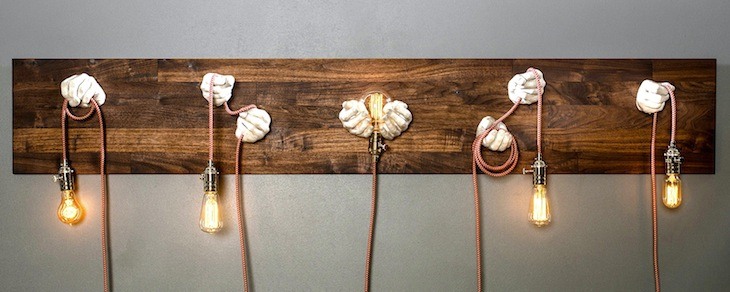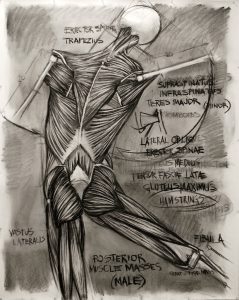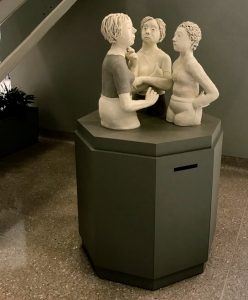Anonymous grant places $350,000 of regional artwork in Arkansas health college
by July 19, 2017 9:50 am 1,518 views

“Hand Lamps” by Mia Hall is a piece of art to be installed in the Arkansas College of Osteopathic Medicine.
Nearly lost in the recent announcement of a second college at the Chaffee Crossing-based Arkansas Colleges of Health Education (ACHE) campus was the receipt of a $350,000 grant to install art in the organization’s inaugural facility — the Arkansas College of Osteopathic Medicine (ARCOM).
The grant money was gifted from an anonymous donor, according to ACHE Executive Director of Development Jackie Krutsch.
“Someone heard us talk about what we were trying to achieve here with the design and architecture of the building. The whole concept was to bring the outdoors in and keep as many of the students here as we could.”
Krutsch told Talk Business & Politics in a recent interview the person who would become the donor said to the school, “‘You know what your building really needs, is art,’ and we said, ‘Yes, we’re aware of that.’ So they really liked our concept and said they wanted to help.”
When ACHE broke ground on ARCOM in March 2015, artwork wasn’t at the top of the priorities list. The ambitious 102,000-square foot, $32.4 million facility had a lot to plan for as the state’s sole independent college devoted to osteopathic medicine — one of only 30 in the United States — welcoming its first class of 150 students in just two years.
Approximately one year later, ARCOM moved from concept to reality, allowing Krutsch and a team consisting of professional artists as well as professors from John Brown University (JBU) and the University of Arkansas at Fort Smith (UAFS) to hone in on the building’s character. They knew a facility of ARCOM’s size needed something to enhance the setting — something that wasn’t so clinical.
An open call for submissions was submitted around December 2016 to regional artists asking for their five best selections. Krutsch’s team sought out artists through recommendations and reputation.
“I believe we sent the call to 92 artists and had about 67 respond. What we have now are 65 pieces from about 47 artists,” Krutsch told Talk Business & Politics, adding that purchases ranged from $1,000 to $8,000 per work with the first works going up in “late March or early April.”

“The committee selected based on the quality of the art,” Krutsch said. “They didn’t say we’re going to need something with teal in it for downstairs. They literally went, ‘Okay, let’s look at this person’s stuff.’ There was a challenge to getting it all placed, and the committee helped in that; but first and foremost, they focused on the art.”
THE WORKS
Krutsch said artists were provided with “half a dozen, maybe more, photos of the building” as a guide for crafting submissions. Some works had been created previously and were in search of the right home. Others, like Mia Hall’s “Hand Lamps,” were made specifically for the call. Hall, a professor at the University of Arkansas at Little Rock (UALR), is interim chair and an associate professor in the university’s department of art and design. Hall used concrete hands in a variety of poses against a heavy wooden backdrop. “The idea of ‘healing hands,'” she wrote in her submission, “feels very appropriate for your building considering the nature of the school.”
In keeping with Hall’s logic, Ernest Cialone, a professor in the UAFS art department, submitted “Wall Lecture Series,” based on his practice of teaching artistic anatomy.
“The works are reminiscent of wall drawings that I create while lecturing the class on the proportions and form of the muscular and skeletal systems of the human body that are of specific utility for artists,” Cialone said, adding that while his class drawings are on inexpensive drawing paper, the Wall Lecture series was created on high-quality, acid-free rag paper.
Cialone’s two portraits are displayed on the second floor, while “Hand Lamps” will hang in the school’s first floor library and be joined by Vinmarie DePoyster’s “Perception,” a painting that appears to be from the point of view of an observer looking up at a giant redwood tree. However, that is not the impression everyone gets when they see it, according to Krutsch.
“Several people have said, ‘It looks like an artery or a vein.’ It’s fun to not say anything because people see different things.”
Not every piece seems custom-made for a medical school — like the colorful giraffe “Effie” and moose “Louie” acrylic-on-canvas paintings from Northwest Arkansas artist Amy Eichler or the picturesque outdoor landscapes from Fort Smith painter Jim Fair. Others — like Barbara Satterfield’s ceramic sculptures from her “pivotal moments” series — celebrate the lives of women. What each piece does do, regardless of being “thematically correct,” is offer students repose from the stressful journey of earning a medical degree.
The spirit of the art program follows a previous concept ACHE implemented with the osteopathic college’s two lecture halls.
The school had purchased 12 photographs from former Fort Smith physician J.P. Bell. Bell is retired from the medical profession and lives in Northwest Arkansas. Today he is an artist, using the Arkansas outdoors as his canvas and photography as his medium of choice. ARCOM’s two windowless lecture halls are nearly identical in appearance. They have only two differences. One is a storm shelter; the other is not. And each features six different Bell photographs enlarged to massive scale and displayed on the walls. An examination of one of these vistas — like the Buffalo River shot, for example, reveals GPS coordinates on the identification tag.

“The idea is you’re in this lecture. It’s stressful. And we want people to fall in love with Arkansas and the region and practice here — in McAlister and Talahina and Little Rock and Jonesboro and Pine Bluff and Sedalia, Mo., and Texarkana,” Krutsch said. “So the idea was to get J.P.’s work in here at a level they can be blown up large. That allows you to take a breath and get lost in the scenery. We added the GPS coordinates, so students could plug those into their phones, and on the rare occasions where they get to really go out and explore, they can say, ‘Man I’ve looked at that for the last seven months. I’m not doing anything Friday. I want to go there. What are we gonna do on this break? I’m not gonna fly back to California to see my family. They’re gonna come here, and I want to show them Arkansas.'”
WHAT’S NEXT?
While Krutsch isn’t ruling out additional art in the years to come, the art program has concluded for now. But the university intends to find one more way of showing appreciation to participants, who have contributed a piece — sometimes several pieces — of their lives for the good of the university.
“We’re actually going to do a reception. We haven’t set the date yet. So many things, everything is new, and you don’t want any kinks in anything because we’re really trying to focus on the students. … We’ve kind of held off. But we want to have just as many of them that can come back and be here at the facility return. I don’t know if it will be open to the general public, or if it’ll be a ticketed event we use as a fundraiser for the students.”
Krutsch expects many will come to the building just for the art, noting that a year after construction on ARCOM had finished, visitors are still coming through.
“We have a lot of people tell us, ‘You know, I went through the building at dedication, but every time I come here, I see or learn something new.'”
For Krutsch, the artwork has been a major factor in encouraging the repeat visits, and that’s a good thing for the artists as well as the university.
“We just see it as a win-win, where the community can come in and see the art, enjoy the art, and learn about who created it, to give the artist exposure. And it also gives the school exposure.”
